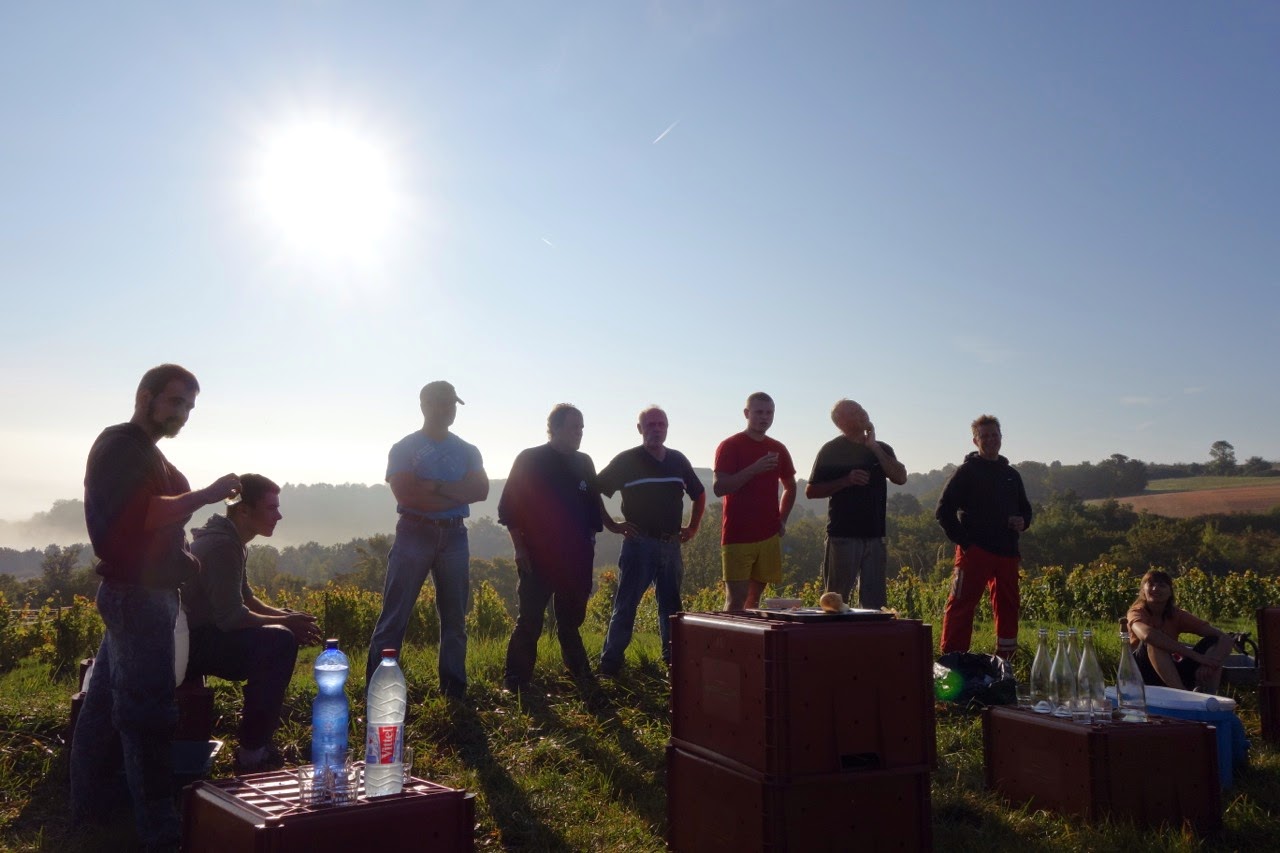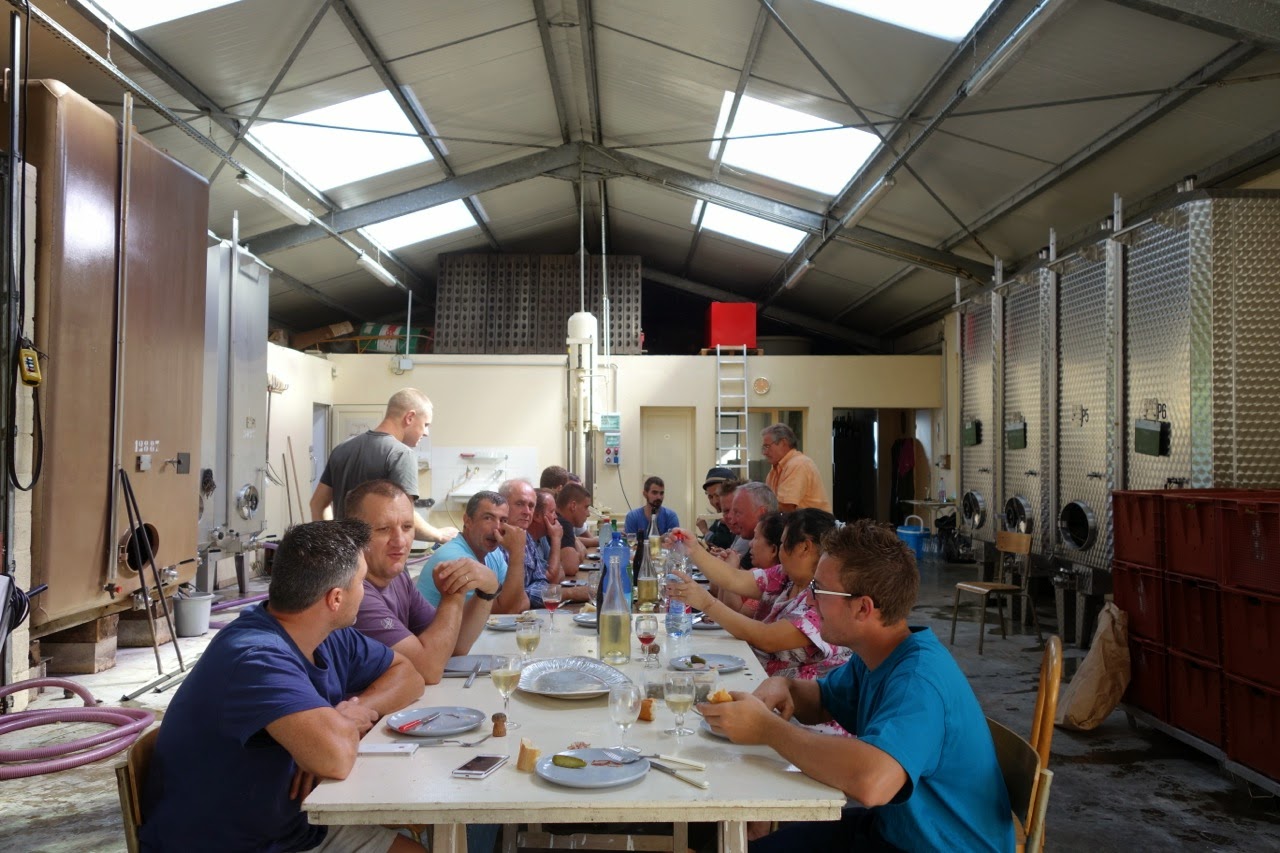When I arranged to harvest with Montgueux Champagne winemaker Manu Lassaigne this September, I had convenience in mind. His is the best domaine in the vicinity of the Native Companion's mother's house outside of Troyes. I figured we could stay with her and sort out transport to and from Montgueux without undue hassle, perhaps on bicycles.
"Attention!" said the NC's mother, when I proposed what struck her as a dangerously bad idea. "Ca mont beaucoup vers Montgueux!" (Tr.: "The way to Montgueux is very steep.") She says this about most hills.* When this failed to sufficiently terrify me, she invoked gypsies. Harvest time brings a lot of low-paid migrant labour to the Aube, and she worried these voyageurs would ambush me with long knives as I bicycled home. "We'll deal with such situations as and when they arise! " I laughed.
And in the end the NC's mom needn't have worried. It took just one day's harvesting at Domaine Jacques Lassaigne for the Native Companion and I to realise we had neither the desire nor the capacity to bike eight kilometers to and from the domaine each day. I was reduced to reliving my early teens, gratefully begging rides to and from my summer job... Harvest is always a blend of festivity and grunt work, in proportions that vary according to the individual traditions of the domaine. Harvest chez Lassaigne is mainly the latter, punctuated with charcuterie and various interesting non-commercialised cuvées.
Some domaines use harvest as a press opportunity, inviting foreign sommeliers and sales representatives to share the experience. Domaine Jacques Lassaigne is not one of these domaines. Manu Lassaigne, a carefree devil at tastings, is all business when it comes to harvest. His team consisted of a core group of former firefighters and young cellarhands, who performed porter work, helped with the wine press, and coordinated the pickers. The pickers consisted of the local under-employed, leathery retirees, young Arab kids, tiny Chinese grandmothers, my girlfriend, and me.
 |
| These two had the natural advantage of possessing an extremely low center of gravity. They barely had to bend down to reach the bunches. |
Following a miscommunication with Manu, we arrived fifteen minutes late on our first day. It wasn't a big deal. But it made our introduction into harvest's most enjoyable tradition all the more surprising: we'd picked for only an hour, barely working up a sweat, when everyone dropped what they were doing and assembled at the end of the field for the 9AM gouter.
The domaine's namesake Jacques Lassaigne (Manu's father) showed up in a van, from which he produced a generous array of charcuterie - andouille, fromage de tête, mousse de foie gras, etc. - along with numerous unmarked bottles of yellowed Champagne.
 |
| This bottle's cork got stuck. So Jacques found a solution. |
This was to prove the high point of each day, the 9AM gouter. Everyone has worked up just a pang of thirst by then, which everyone slakes immediately with Champagne. But no one is quite verbal yet, due to the early hour. Cigarettes get lit. The pickers sit on thrones of overturned grape bins and gaze downhill at the lowland fog dissipating in the horizontal morning sun.
Then it's back to work.
The 2014 harvest was completed in about six days. With the exception of a brief storm on the fifth evening, the weather was splendid throughout. I think I can count on one hand the times I encountered rot or mold over the course of four days. The domaine's vines are astonishingly pristine.
Their beaming, rude health was especially striking in contrast to the Poulsard vineyards I'd been harvesting just days before in the Jura, which had suffered about 50% losses due to cherry vinegar flies...
Among the last vines we harvested were the younger vines in the Clos Sainte Sophie, the Aube's only Clos, from which Manu Lassaigne has been purchasing grapes since 2010 for a yet-to-be-released cuvée.
Interestingly, this historic vineyard is, at least to my superficial perspective, significantly less well-tended than Lassaigne's own vines further up the hill. There isn't the same grass coverage between rows; the earth is at once dustier and more impacted. The occasional Pinot vine is found among the Chardonnay, but all is harvested and vinified together.
 |
| An historic wine press on display in a barn by the Clos Sainte Sophie. |
The Native Companion and I made potato salad for the occasion. It's amazing how much shared food improves the ambience at a table. (My impression is that when you gather random French workers around a lunch table, everyone's first priority is not to be judged, whether on the quality of one's packed lunch or on one's manner of consuming it. Nourishment comes second.)
All meals were more or less rescued by Champagne, however. I later learned that the cuvée served to harvesters at morning gouter and lunch was an experimental barrel that Lassaigne left outside the cellar in the elements for a year. (This explained the slightly darker colour.) It reminded me more than a little of Jean-François Ganevat's sparkling wine: low-toned, short and pure on the palate, with savoury herbaceous notes.
Manu Lassaigne also produces, but doesn't sell, a lovely still Coteaux Champenois red from purchased Pinot Noir. He vinifies it in a notably Beaujolais-like, vin de soif style, and does all pigeage himself. He says he only makes it because his father enjoys reds, but, amusingly, Jacques later confided that he doesn't like the wine's Beaujolais-like, vin de soif style.
I had intended only to work three days of harvest, but it seemed a shame to miss "le chien," which is local slang for the end-of-harvest festivities. So I came back for a fourth day. The NC explained that at certain other Aubois domaines le chien is a riotous party long into the night. Chez Lassaigne it was sort of like a long, seated gouter, after which Manu gave the pickers a tour of the cellar.
I'd already seen the cellar on two other occasions. But for my efforts Lassaigne slipped me a bottle of yet another non-commercialised cuvée he makes from time to time, a still red Gamay. I'd had no idea any Gamay was grown that far north, but apparently so.
The bottle was from 2008. Was 2008 a good year for Coteaux Champanois Gamay? Who knows? I opened it for the occasion of a chef friend's birthday at L'Amitié Rit in Montreuil, only to have the bar owner, Thierry, rightly point out that we probably ought to have carafed it for an hour... It was a dense, high-acid, peppery black Gamay, which only began to show appreciable fruit on its final sips.
* The NC's mother, bless her, is prone to issuing morbid predictions no matter how benign or anodyne the circumstances: if one of us is, for example, about purchase a train ticket at the station, she'll announce that it might rain, there might be no seats left on the train, and that vikings will invade.
Champagne Jacques Lassaigne
7, Chemin des Haies
10300 MONTGUEUX
Tel: 03 25 74 84 83
Related Links:














No comments:
Post a Comment